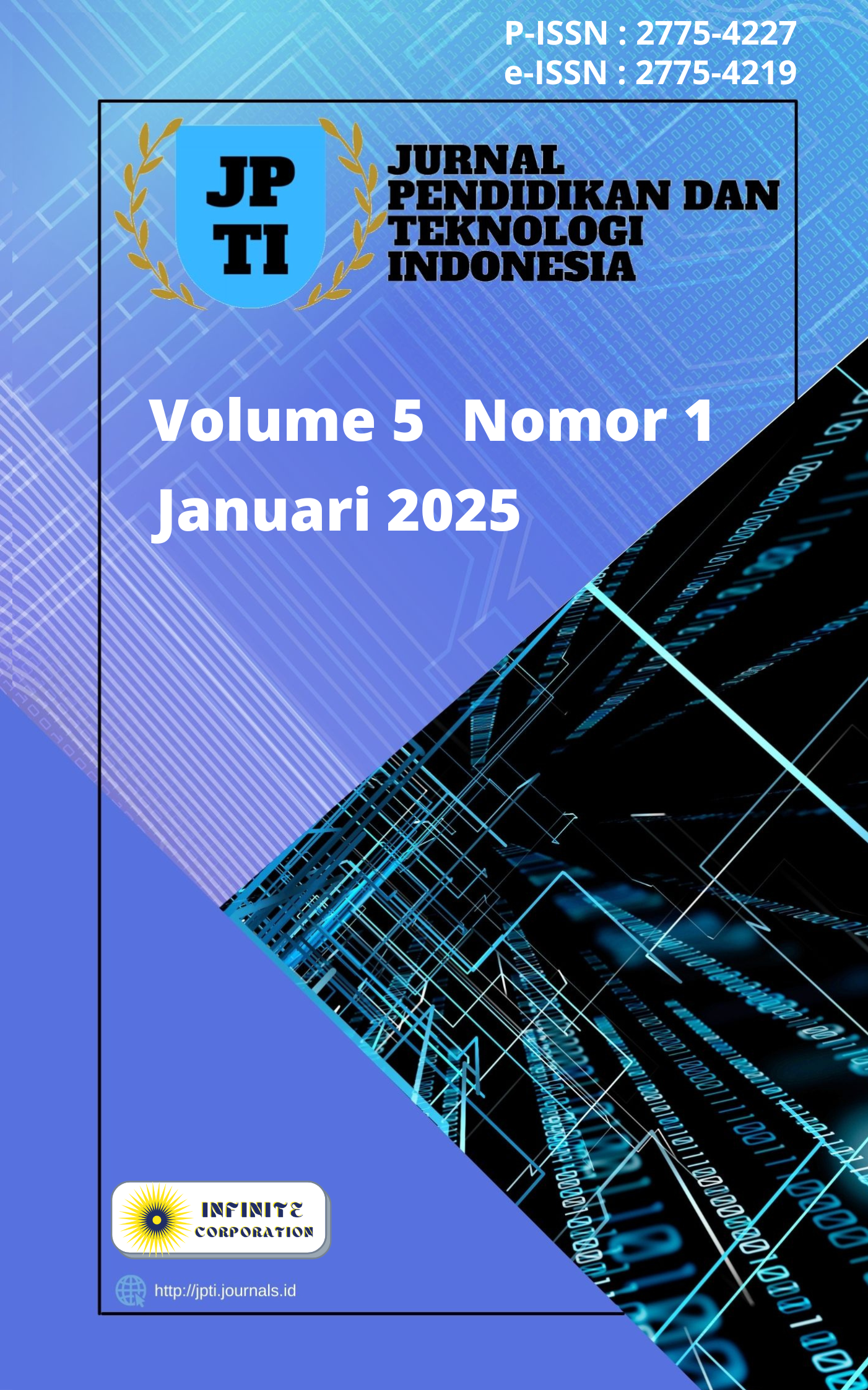Analisis Performa Algoritma XGBoost, GRU, dan Prophet dalam Peramalan Penjualan Obat untuk Optimasi Rantai Pasok Farmasi
DOI:
https://doi.org/10.52436/1.jpti.562Kata Kunci:
GRU, Machine Learning, Penjualan Obat, Prophet, XGBoostAbstrak
Penelitian ini bertujuan untuk meningkatkan efisiensi dan akurasi manajemen stok farmasi dengan mengevaluasi efektivitas peramalan dari tiga algoritma deret waktu yang populer — XGBoost, GRU, dan Prophet — pada data penjualan obat. Masalah utama dalam manajemen stok farmasi adalah ketidakakuratan peramalan, yang dapat menyebabkan kehabisan stok atau kelebihan inventaris, sehingga berdampak pada biaya operasional dan kepuasan pelanggan. Berdasarkan hasil evaluasi menggunakan berbagai metrik, XGBoost menunjukkan performa terbaik dengan nilai MSE terendah sebesar 16,1885, RMSE sebesar 4,0234, MAE sebesar 2,6427, MAPE sebesar 4,3535%, dan R-Squared sebesar 0,9646 pada rasio data latih sebesar 60%. Sebaliknya, GRU dan Prophet menunjukkan hasil yang kurang stabil, dengan nilai kesalahan prediksi lebih tinggi di seluruh metrik. Temuan ini memberikan kontribusi signifikan bagi manajemen rantai pasok farmasi dengan mendukung strategi berbasis data yang dapat meningkatkan efisiensi operasional dan kepuasan konsumen.
Unduhan
Referensi
T. R. Indarti, S. Satibi, and E. Yuniarti, “Pengendalian Persediaan Obat dengan Minimum-Maximum Stock Level di Instalasi Farmasi RSUP Dr. Sardjito Yogyakarta,” JURNAL MANAJEMEN DAN PELAYANAN FARMASI (Journal of Management and Pharmacy Practice), vol. 9, no. 3, p. 192, Sep. 2019, doi: 10.22146/jmpf.45295.
S. Satibi, A. Fudholi, E. C. Tuko, and G. L. Swastiandari, “The Inventory Control, Storage Facilities and Distribution at Pharmaceutical Industry in Supporting Drugs Availability of JKN Era,” JURNAL MANAJEMEN DAN PELAYANAN FARMASI (Journal of Management and Pharmacy Practice), vol. 9, no. 1, p. 27, Mar. 2019, doi: 10.22146/jmpf.43162.
L. Subramanian, “Effective Demand Forecasting in Health Supply Chains: Emerging Trend, Enablers, and Blockers,” Logistics, vol. 5, no. 1, Mar. 2021, doi: 10.3390/logistics5010012.
S. Chauhan, R. Singh, A. Gehlot, S. V. Akram, B. Twala, and N. Priyadarshi, “Digitalization of Supply Chain Management with Industry 4.0 Enabling Technologies: A Sustainable Perspective,” Processes, vol. 11, no. 1, Jan. 2023, doi: 10.3390/pr11010096.
I. Oubrahim, N. Sefiani, and A. Happonen, “The Influence of Digital Transformation and Supply Chain Integration on Overall Sustainable Supply Chain Performance: An Empirical Analysis from Manufacturing Companies in Morocco,” Energies (Basel), vol. 16, no. 2, Jan. 2023, doi: 10.3390/en16021004.
J. Y. Ma, L. Shi, and T. W. Kang, “The Effect of Digital Transformation on the Pharmaceutical Sustainable Supply Chain Performance: The Mediating Role of Information Sharing and Traceability Using Structural Equation Modeling,” Sustainability (Switzerland), vol. 15, no. 1, Jan. 2023, doi: 10.3390/su15010649.
B. Jange, “Prediksi Harga Saham Bank BCA Menggunakan XGBoost,” ARBITRASE: Journal of Economics and Accounting, vol. 3, no. 2, pp. 231–237, Nov. 2022, doi: 10.47065/arbitrase.v3i2.495.
M. Alim, G. H. Ye, P. Guan, D. S. Huang, B. Sen Zhou, and W. Wu, “Comparison of ARIMA model and XGBoost model for prediction of human brucellosis in mainland China: A time-series study,” BMJ Open, vol. 10, no. 12, Dec. 2020, doi: 10.1136/bmjopen-2020-039676.
M. Abumohsen, A. Y. Owda, and M. Owda, “Electrical Load Forecasting Using LSTM, GRU, and RNN Algorithms,” Energies (Basel), vol. 16, no. 5, Mar. 2023, doi: 10.3390/en16052283.
C. Chen, L. Xue, and W. Xing, “Research on Improved GRU-Based Stock Price Prediction Method,” Applied Sciences (Switzerland), vol. 13, no. 15, Aug. 2023, doi: 10.3390/app13158813.
S. J. Taylor and B. Letham, “Forecasting at Scale,” 2017, doi: 10.7287/peerj.preprints.3190v2.
R. H. Pratama and P. H. Gunawan, “YouTube Viewership Increation Analysis and Prediction using Facebook Prophet Model,” JURNAL MEDIA INFORMATIKA BUDIDARMA, vol. 8, no. 1, p. 383, Jan. 2024, doi: 10.30865/mib.v8i1.7240.
C. B. Aditya Satrio, W. Darmawan, B. U. Nadia, and N. Hanafiah, “Time series analysis and forecasting of coronavirus disease in Indonesia using ARIMA model and PROPHET,” in Procedia Computer Science, Elsevier B.V., 2021, pp. 524–532. doi: 10.1016/j.procs.2021.01.036.
Milan Zdravkovi?, “Pharma sales data,” 2020, doi: 10.34740/kaggle/ds/466126.
A. Prakash, J. Thangaraj, S. Roy, S. Srivastav, and J. K. Mishra, “Model-Aware XGBoost Method Towards Optimum Performance of Flexible Distributed Raman Amplifier,” IEEE Photonics J, vol. 15, no. 4, Aug. 2023, doi: 10.1109/JPHOT.2023.3286272.
L. Yan and Y. Xu, “XGBoost-Enhanced Graph Neural Networks: A New Architecture for Heterogeneous Tabular Data,” Applied Sciences (Switzerland), vol. 14, no. 13, Jul. 2024, doi: 10.3390/app14135826.
U. I. Arfianti, D. C. R. Novitasari, N. Widodo, Moh. Hafiyusholeh, and W. D. Utami, “Sunspot Number Prediction Using Gated Recurrent Unit (GRU) Algorithm,” IJCCS (Indonesian Journal of Computing and Cybernetics Systems), vol. 15, no. 2, p. 141, Apr. 2021, doi: 10.22146/ijccs.63676.
M. Zhang et al., “Application of Gated Recurrent Unit Neural Network for Flood Extraction from Synthetic Aperture Radar Time Series,” Water (Switzerland), vol. 15, no. 21, Nov. 2023, doi: 10.3390/w15213779.
T. Toharudin, R. S. Pontoh, R. E. Caraka, S. Zahroh, Y. Lee, and R. C. Chen, “Employing long short-term memory and Facebook prophet model in air temperature forecasting,” Commun Stat Simul Comput, vol. 52, no. 2, pp. 279–290, 2023, doi: 10.1080/03610918.2020.1854302.
D. Sitompul and R. Puspasari, “Perancangan Aplikasi Peramalan Penjualan Minyak Solar PT. Willy Dwi Perkasa Menggunakan Metode Single Exponential Smoothing Design of Solar Oil Sales Forecasting Application PT. Willy Dwi Perkasa uses the Single Exponential Smoothing Method,” 2023. [Online]. Available: http://kti.potensi-utama.ac.id/index.php/JUREKSI/index
K. Posch, C. Truden, P. Hungerländer, and J. Pilz, “A Bayesian Approach for Predicting Food and Beverage Sales in Staff Canteens and Restaurants,” May 2020, doi: 10.1016/j.ijforecast.2021.06.001.
A. Satyo Bayangkari Karno, J. K. Noer Ali, and K. Bekasi, “Prediksi Data Time Series Saham Bank BRI Dengan Mesin Belajar LSTM (Long ShortTerm Memory),” Journal of Information and Information Security (JIFORTY), vol. 1, no. 1, pp. 1–8, 2020, [Online]. Available: http://ejurnal.ubharajaya.ac.id/index.php/jiforty
Sabar Sautomo and Hilman Ferdinandus Pardede, “Prediksi Belanja Pemerintah Indonesia Menggunakan Long Short-Term Memory (LSTM),” Jurnal RESTI (Rekayasa Sistem dan Teknologi Informasi), vol. 5, no. 1, pp. 99–106, Feb. 2021, doi: 10.29207/resti.v5i1.2815.
S. M. Robeson and C. J. Willmott, “Decomposition of the mean absolute error (MAE) into systematic and unsystematic components,” PLoS One, vol. 18, no. 2 February, Feb. 2023, doi: 10.1371/journal.pone.0279774.
Y. Wang, Z. Yan, and L. Xing, “A Movie Score Prediction Model Based on XGBoost Algorithm,” in Proceedings - 2021 International Conference on Culture-Oriented Science and Technology, ICCST 2021, Institute of Electrical and Electronics Engineers Inc., 2021, pp. 486–491. doi: 10.1109/ICCST53801.2021.00108.
D. Chicco, M. J. Warrens, and G. Jurman, “The coefficient of determination R-squared is more informative than SMAPE, MAE, MAPE, MSE and RMSE in regression analysis evaluation,” PeerJ Comput Sci, vol. 7, pp. 1–24, 2021, doi: 10.7717/PEERJ-CS.623.























